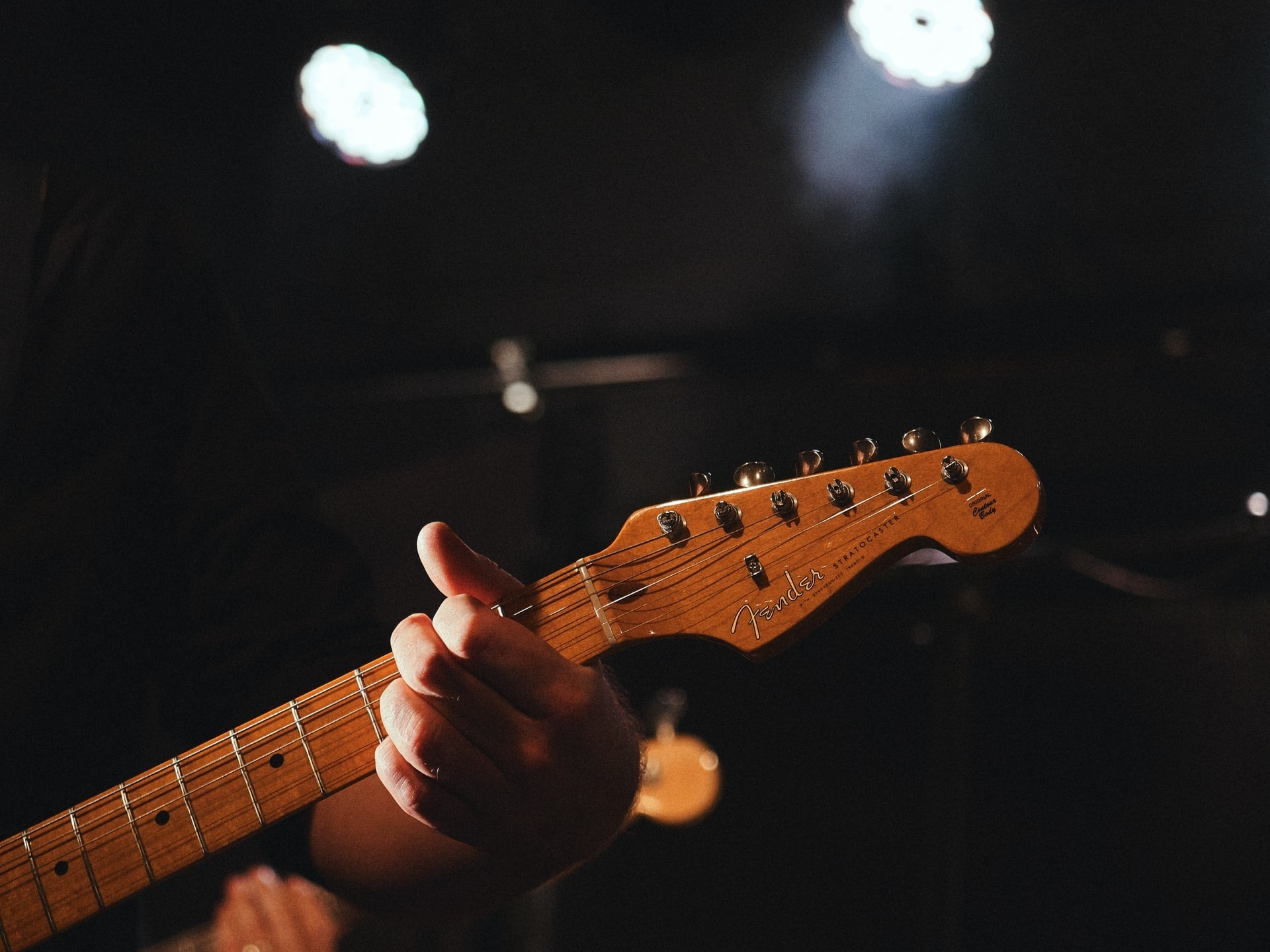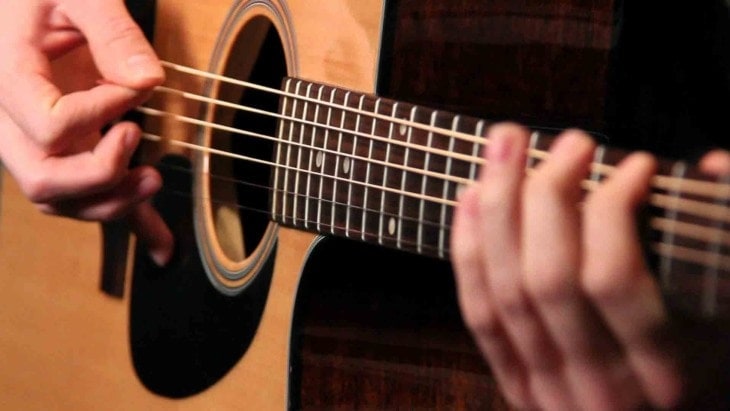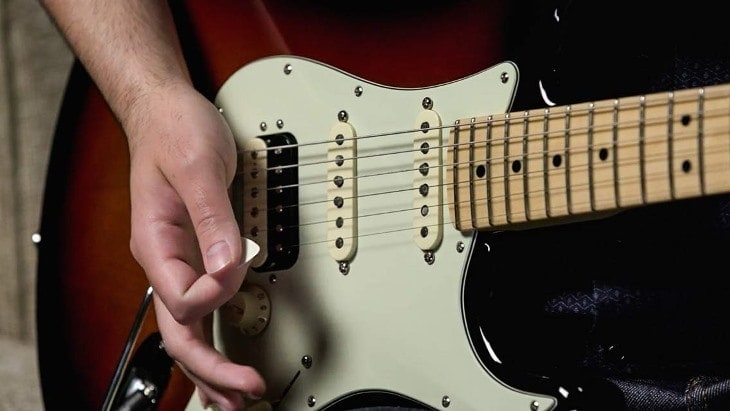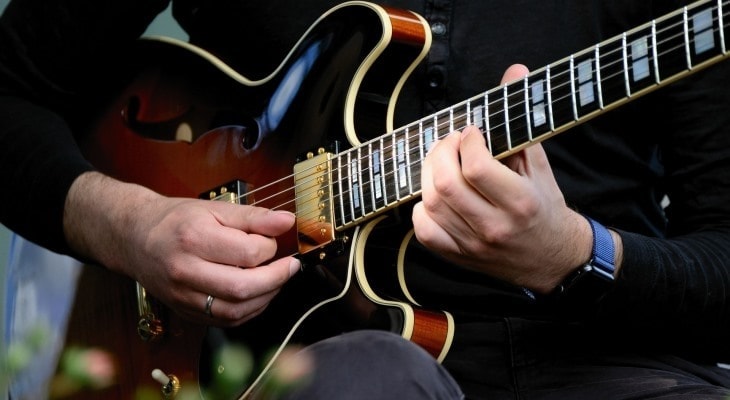Practicing guitar can be a loud thing, even for acoustic players.
There are times or situations where you still want to practice, but you can’t be too loud to avoid disturbing those around you.
Luckily, there are a few ways that you can still hone your skills without waking the neighbors.
Let’s go over some of the ways to practice guitar as quietly as possible.
Table of Contents
Practicing Electric Guitar Quietly

Electric guitars are normally practiced with an amp that has its volume and gain turned up to 11, but there are ways that we can still practice guitar without using a loud amp.
Practice Without an Amp
The first and most obvious way to practice quietly is without plugging into an amp.
Electric guitars are still audible when not plugged in, and you can still practice your technique on it ‘acoustically’.
This is a method I use quite often when practicing at night. I can keep playing for as long as I want without disturbing anyone.
Of course, this means that you won’t be using any gain or effects, but this is still a good way of practicing if you want to just work on your technique or just want to practice things like scales and modes.
If you still want to practice with some gain, you can use a mini amp.
You can buy mini amps suited for apartment practice, like this Danelectro Honeytone, and use them to practice quietly.
Mini amps are very low power, so they don’t produce a lot of volume. They also usually have a headphone output if you need to be absolutely noiseless.
Practice with Headphones
Apart from mini amps, there are a few other options for practicing with headphones.
An alternative to mini amps is mini amp sims. Amp sims are great because they are cheap, very small, and easy to use. The Vox amPlug 2 fits in the palm of your hand and has a standard 1/8-inch (3.5mm) headphone output
A lot of modern amps have headphone outputs specifically for practicing quietly.
Something like this Boss Katana-50 MKII is a great option because it also has a power control that goes all the way down to half a watt. So, it can be used as a sort of mini amp as well.
You can also use an audio interface for practicing with headphones.
Audio interfaces are great for practicing in general, as you can record yourself playing and then listen back to what you played. This helps if you want to perfect your timing and clarity of playing.
They also allow you to play with effects using plugins on your digital audio workstation of choice.
Just be sure to get an audio interface with an input for instruments since not all of them have one. My pick would be the Focusrite Scarlett Solo. Focusrite audio interfaces are very great and the Solo is fairly cheap.
Another way to practice with headphones if you also want effects is to use a multi-effects pedal.
Most modern multi-effects pedals have headphone outputs and are capable of reproducing the sounds of various amps and pedals.
This Line 6 POD Go for example has over 270 different amp, cabinet, and pedal models that you can combine to get virtually any sound you want.
Using headphones with an amp, audio interface, or multi-effects, it’s important to remember that you’ll probably need a 1/8-to-1/4-inch adapter to be able to plug your headphones in.
Practicing Acoustic Guitar Quietly

Unlike electric guitars, acoustic guitars can’t just have their volume turned down.
There are a few ways to make acoustic guitars less of a disturbance to those around you.
Dampening the Sound
There are a few ways you can dampen the sound on an acoustic guitar and make it more suitable for quiet practice.
The cheapest solution is to simply take one or two of your shirts, and place them inside your guitar’s body.
They will dampen the sound, making the guitar softer while you play. The downside of this method is that it can be a hassle to get the shirts in and out of the guitar.
This is still a good solution in a pinch if you need to make your acoustic quieter.
For a better long-term or frequent solution, you can use a piece of rubber or foam to dampen the sound.
Simply place the rubber or foam underneath the strings to ‘mute’ them. The best place for this is on the body by the bridge. You might just need to adjust the piece of dampening material until your getting a good enough sound, while still dampening it.
You can also buy rubber silencers made for this purpose.
You can also buy a soundhole dampener to placed inside the body. These dampeners cover the soundhole which reduces the volume that the guitar produces.
Although good at dampening the sound, soundhole dampeners aren’t as good as muting the strings with a rubber silencer or foam.
Using a Travel Guitar
The best, but certainly most expensive option, is to buy a travel guitar.
Specifically, a ‘silent’ travel guitar that doesn’t have a soundhole. A solid body acoustic-electric guitar, like this Traveler Guitar Escape Mark III or something similar that also has a headphone input.
This will give you the best playing experience without being loud. Travel guitars are also smaller, so storing them and transporting them isn’t much of a hassle.
Practice in a Quiet Area
Choosing where you practice is also a good way to ensure that you’re not disturbing anyone else. A small, sound-treated room is the best place to practice without being too loud.
DIY Sound Treatment
The best place to practice is in a room that has only a carpeted floor and doesn’t have tiles or wood.
This is because carpet absorbs more sound than it reflects, which will dampen the sound coming from the room. You can improve the rooms dampening by also making the walls and windows less reflective.
Putting up thick curtains in front of the windows will absorb more sound than thin curtains or blinds. Keeping the windows closed will help a bit by letting less sound leave the room.
Keep any empty egg boxes/cartons to place against the windows as well. The shape of the boxes helps to diffuse sound, which helps to keep the room quieter.
Placing towels or blankets over the gaps around doors is also a good way to dampen the sound leaving the room.
Covering the walls with blankets, placing mattresses in front of walls – all these are effective ways of creating a cheap sound treatment for a room.
Professional Sound Treatment
Of course, the best way to sound treat a room is by getting professional-quality materials.
Fortunately, you don’t need to hire a professional to install sound treatment in your room. This is certainly the best option, but these days you can do it yourself.
You can buy acoustic foam kits like these that can easily be put up on the walls in your room. You can also check out our detailed buying guide on acoustic panels.
These kits aren’t the cheapest solution, but they are easy to put up and come in different colors. So, if you want the acoustic treatment to look nice, with a bit of a ‘custom’ flair, you can certainly do that.
Other Quiet Practice Methods
Besides all these ‘big’ ways to practice guitar quietly, there are a few smaller ways that you can reduce the volume of your guitar, and even practice completely silently.
Palm Muting

Not only is palm muting a good way to dampen the sound of your guitar, but it’s also a good technique to learn overall.
Heavy palm muting can reduce the guitar’s sound enough that it won’t be disturbing to those around you.
The downside is that you won’t be able to practice strumming, but you can still practice your fretting technique, chords, scales, etc.
Using Thin Gauge Strings
Lighter gauge strings are a little bit quieter than heavier gauge.
If you go down to 0.9 or lower, the strings will produce less lows than heavier gauge strings. Low frequencies travel further and better through things like walls and doors.
Going with a lighter gauge, however, will affect the way you play and your tone. The tone will be brighter, and if you’re not used to a lighter gauge, they can be uncomfortable to play and can cut into your fingers.
Play Without a Guitar
There are things that help improve your skill as a guitarist that you can still practice without having to actually play.
You can still learn how to read music, music theory, and do ear training with apps, all without ever needing to pick up a guitar.
These are all very valuable things to know if you want to be as good a musician as possible.
You can also memorize the notes on the fretboard without a guitar.
Simply draw a fretboard on a piece of paper, and then try to fill in the notes on each string and fret.
Conclusion
Hopefully, with all these tips and tricks, you’ll be able to practice and improve your skill without worrying about disturbing your neighbors or roommates.

